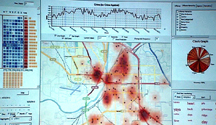Purdue software toolkit provides visual analytics to aid law enforcement, first-responders
September 24, 2013
 |
|
John Goetz, Purdue University police patrol sergeant, uses the Visual Analytics Law Enforcement Toolkit, or VALET, to track traffic and civil incident data. VALET is being developed by Purdue's Visual Analytics for Command, Control and Interoperability Environments, which is a U.S. Homeland Security Center of Excellence. (Photo provided by Purdue Research Foundation) |
WEST LAFAYETTE, Ind. - Purdue University researchers have developed a new tool for law enforcement officers and disaster assistance first-responders to reduce crime and assist people. The tool is called the Visual Analytics Law Enforcement Toolkit, or VALET (pdf).
Developed at Purdue's Homeland Security Center of Excellence, the toolkit software provides real-time data so officers can analyze high-volume criminal, traffic and civil incident data as well as related emergency management and disaster preparedness events so they can be more strategic in how they allocate resources in their communities.
"One of my sayings is, 'We need to work smarter, not harder,' and the VALET toolkit allows us to pull data so we are in a better position to put officers in the right place at the right time when a situation arises," said John K. Cox, Purdue University chief of police. "Providing this type of situational awareness gives us the higher level of assessment so we can better cover high-crime areas or give officers context of what is happening so they know what they are walking into when on patrol or responding to a call."
 |
|
The Visual Analytics Law Enforcement Toolkit, or VALET, is a software toolkit that provides real-time data so law enforcement officers can analyze high-volume criminal, traffic and civil incident data. The technology also can be used by first responders of emergency management and preparedness in times of disaster so they can be more strategic in how they allocate resources in their communities. (Screen shot provided by Purdue Research Foundation) |
According to a statistical analysis based on historical data, the software program includes temporal prediction algorithms to forecast future criminal, traffic and civil incident levels within a 95 percent confidence interval, meaning the estimates of the collected data could be reliably repeated and used to predict future behaviors or actions.
The VALET software can be used on most computers, and its companion software, called iVALET, has been designed specifically for the iPhone and iPad.
Law enforcement agencies can receive trial versions of the software packages through Purdue's Visual Analytics for Command, Control and Interoperability Environments, or VACCINE.
"Predictive and proactive analytics that creates a picture of what is happening at any given time and what could happen in an hour or a day or a week is a tremendous help for law enforcement and disaster relief officials," said David Ebert, director of Purdue's Visual Analytics for Command, Control and Interoperability Environments, which is a U.S. Homeland Security Center of Excellence.
The technology enables law enforcement agencies to interactively visualize and analyze their datasets in linked geospatial or mapping and temporal views of time graphs, calendars and clock views.
"We are doing more than providing law enforcement officers with specific data covering their areas, because we've developed a portal for potential other issues such as prominent calendar dates, zoning tracts and even weather reports to help officers in their daily routines to protect the public," said Abish Malik, a graduate research assistant in the School of Electrical and Computer Engineering.
Collaborators in the development of VALET include the Purdue University and West Lafayette police departments, Tippecanoe County Sheriff's Office and the Ohio State Highway Patrol. The U.S. Department of Homeland Security, Command, Control and Interoperability Center of Excellence at Purdue University provided funding for the project.
A video about VALET and iVALET is available at http://youtu.be/b3RVpGOMK6I
Purdue University's other patented technologies include new cancer treatments, alternative fuels, biomedical devices, agriculture innovations and others that are available for licensing through the Office of Technology Commercialization. For more information, call 765-588-3475, email otcip@prf.org or visit otc-prf.org/otc.
Contact: Cynthia Sequin, (765) 588-3340, casequin@prf.org
Sources: David Ebert, (765) 494-9064, ebert@purdue.edu
John Cox, jkcox@purdue.edu
Abish Malik, amalik@purdue.edu
